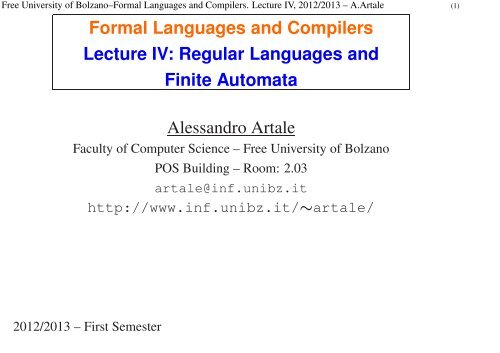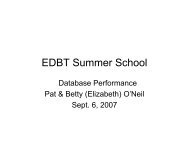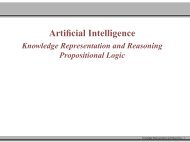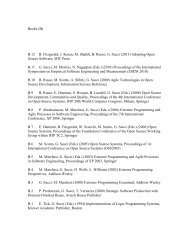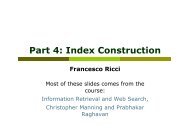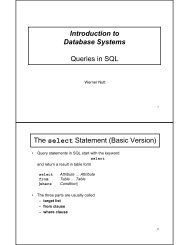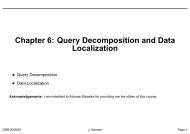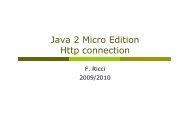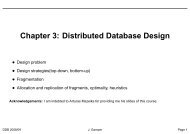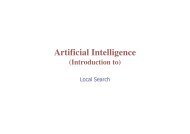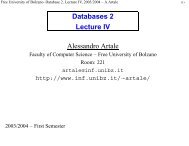Regular Languages and Finite Automata - Faculty of Computer ...
Regular Languages and Finite Automata - Faculty of Computer ...
Regular Languages and Finite Automata - Faculty of Computer ...
Create successful ePaper yourself
Turn your PDF publications into a flip-book with our unique Google optimized e-Paper software.
Free University <strong>of</strong> Bolzano–Formal <strong>Languages</strong> <strong>and</strong> Compilers. Lecture IV, 2012/2013 – A.Artale (1)<br />
Formal <strong>Languages</strong> <strong>and</strong> Compilers<br />
Lecture IV: <strong>Regular</strong> <strong>Languages</strong> <strong>and</strong><br />
<strong>Finite</strong> <strong>Automata</strong><br />
Aless<strong>and</strong>ro Artale<br />
<strong>Faculty</strong> <strong>of</strong> <strong>Computer</strong> Science – Free University <strong>of</strong> Bolzano<br />
POS Building – Room: 2.03<br />
artale@inf.unibz.it<br />
http://www.inf.unibz.it/∼artale/<br />
2012/2013 – First Semester
Free University <strong>of</strong> Bolzano–Formal <strong>Languages</strong> <strong>and</strong> Compilers. Lecture IV, 2012/2013 – A.Artale (2)<br />
Summary <strong>of</strong> Lecture IV<br />
• <strong>Regular</strong> Expressions (RE).<br />
• Implementing a Recognizer <strong>of</strong> RE’s: <strong>Automata</strong>.<br />
– Deterministic <strong>Finite</strong> <strong>Automata</strong> (DFA).<br />
– Nondeterministic <strong>Finite</strong> <strong>Automata</strong> (NFA).<br />
– From <strong>Regular</strong> Expressions to NFA.<br />
– ǫ-NFA: NFA with ǫ Transitions.<br />
– From NFA to DFA.
Free University <strong>of</strong> Bolzano–Formal <strong>Languages</strong> <strong>and</strong> Compilers. Lecture IV, 2012/2013 – A.Artale (3)<br />
<strong>Regular</strong> Expressions<br />
Each <strong>Regular</strong> Expression, say R, denotes a Language, L(R). The following are<br />
the rules to build them over an alphabet V:<br />
1. If a ∈ V ∪ {ǫ} then a is a <strong>Regular</strong> Expression denoting the language {a};<br />
2. If R, S are <strong>Regular</strong> Expressions denoting the <strong>Languages</strong> L(R) <strong>and</strong> L(S)<br />
then:<br />
(a) R | S is a <strong>Regular</strong> Expression denoting L(R) ∪ L(S);<br />
(b) R · S is a <strong>Regular</strong> Expression denoting the concatenation L(R) · L(S),<br />
i.e., L(R) · L(S) = {r · s | r ∈ L(R) <strong>and</strong> s ∈ L(S)};<br />
(c) R ∗ (Kleen closure) is a <strong>Regular</strong> Expression denoting L(R) ∗ , zero or<br />
more concatenations <strong>of</strong> L(R), i.e., L(R) ∗ = ⋃ ∞<br />
i=0 L(R)i —where<br />
L(R) 0 = {ǫ};<br />
(d) (R) is a <strong>Regular</strong> Expression denoting L(R).<br />
Precedence <strong>of</strong> Operators: ∗ > · > |<br />
E | F · G ∗ = E | (F · (G ∗ ))
Free University <strong>of</strong> Bolzano–Formal <strong>Languages</strong> <strong>and</strong> Compilers. Lecture IV, 2012/2013 – A.Artale (4)<br />
<strong>Regular</strong> Expressions: Examples<br />
Example. Let V = {a, b}.<br />
1. The <strong>Regular</strong> Expression a | b denotes the Language {a, b}.<br />
2. The <strong>Regular</strong> Expression (a | b)(a | b) denotes the Language {aa, ab, ba, bb}.<br />
3. The <strong>Regular</strong> Expression a ∗ denotes the Language <strong>of</strong> all strings <strong>of</strong> zero or<br />
more a’s, {ǫ, a, aa, aaa, . . .}.<br />
4. The <strong>Regular</strong> Expression (a | b) ∗ denotes the Language <strong>of</strong> all strings <strong>of</strong> a’s<br />
<strong>and</strong> b’s.
Free University <strong>of</strong> Bolzano–Formal <strong>Languages</strong> <strong>and</strong> Compilers. Lecture IV, 2012/2013 – A.Artale (5)<br />
<strong>Regular</strong> Expressions: Shorth<strong>and</strong>s<br />
Notational shorth<strong>and</strong>s are introduced for frequently used constructors.<br />
1. +: One or more instances. If R is a <strong>Regular</strong> Expression then R + ≡ RR ∗ .<br />
2. ?: Zero or one instance. If R is a <strong>Regular</strong> Expression then R? ≡ ǫ | R.<br />
3. Character Classes. If a, b, . . . , z ∈ V then [a, b, c] ≡ a | b | c, <strong>and</strong><br />
[a − z] ≡ a | b | . . . | z.
Free University <strong>of</strong> Bolzano–Formal <strong>Languages</strong> <strong>and</strong> Compilers. Lecture IV, 2012/2013 – A.Artale (6)<br />
<strong>Regular</strong> Definitions<br />
• <strong>Regular</strong> Definitions are used to give names to regular Expressions <strong>and</strong> then<br />
to re-use these names to build new <strong>Regular</strong> Expressions.<br />
• A <strong>Regular</strong> Definition is a sequence <strong>of</strong> definitions <strong>of</strong> the form:<br />
D 1 → R 1<br />
D 2 → R 2<br />
. . .<br />
D n → R n<br />
Where each D i is a distinct name <strong>and</strong> each R i is a <strong>Regular</strong> Expression over<br />
the extended alphabet V ∪ {D 1 , D 2 , . . . , D i−1 }.<br />
• Note: Such names for <strong>Regular</strong> Expression will be <strong>of</strong>ten the Tokens returned<br />
by the Lexical Analyzer. As a convention, names are printed in boldface.
Free University <strong>of</strong> Bolzano–Formal <strong>Languages</strong> <strong>and</strong> Compilers. Lecture IV, 2012/2013 – A.Artale (7)<br />
<strong>Regular</strong> Definitions: Examples<br />
Example 1. Identifiers are usually strings <strong>of</strong> letters <strong>and</strong> digits beginning with a<br />
letter:<br />
letter → A | B |. . .| Z | a | b | . . . | z<br />
digit → 0 | 1 | · · · | 9<br />
id → letter(letter | digit) ∗<br />
Using Character Classes we can define identifiers as:<br />
id → [A − Za − z][A − Za − z0 − 9] ∗
Free University <strong>of</strong> Bolzano–Formal <strong>Languages</strong> <strong>and</strong> Compilers. Lecture IV, 2012/2013 – A.Artale (8)<br />
<strong>Regular</strong> Definitions: Examples (Cont.)<br />
Example 2. Numbers are usually strings such as 5230, 3.14, 6.45E4, 1.84E-4.<br />
digit → 0 | 1 | · · · | 9<br />
digits → digit +<br />
optional-fraction → (.digits)?<br />
optional-exponent → (E(+ | −)?digits)?<br />
num → digits optional-fraction optional-exponent
Free University <strong>of</strong> Bolzano–Formal <strong>Languages</strong> <strong>and</strong> Compilers. Lecture IV, 2012/2013 – A.Artale (9)<br />
<strong>Regular</strong> Expressions VS. <strong>Regular</strong> Grammars<br />
• <strong>Languages</strong> captured by <strong>Regular</strong> Expressions could be captured by <strong>Regular</strong><br />
Grammars (Type 3 Grammars).<br />
• <strong>Regular</strong> Expressions are a notational variant <strong>of</strong> <strong>Regular</strong> Grammars:<br />
Usually they give a more compact representation.<br />
• Example. The <strong>Regular</strong> Expression for numbers can be captured by a <strong>Regular</strong><br />
Grammar with the following Productions (num is the scope <strong>and</strong> digit is a<br />
terminal symbol):<br />
num → digit | digit Z<br />
Z → digit | digit Z | . Frac-Exp | E Exp-Num<br />
Frac-Exp → digit | digit Frac-Exp | digit Exp<br />
Exp → E Exp-Num<br />
Exp-Num → +Digits | −Digits | digit | digit Digits<br />
Digits → digit | digit Digits
Free University <strong>of</strong> Bolzano–Formal <strong>Languages</strong> <strong>and</strong> Compilers. Lecture IV, 2012/2013 – A.Artale (10)<br />
Summary<br />
• <strong>Regular</strong> Expressions.<br />
• Implementing a Recognizer <strong>of</strong> RE’s: <strong>Automata</strong>.<br />
– Deterministic <strong>Finite</strong> <strong>Automata</strong> (DFA).<br />
– Nondeterministic <strong>Finite</strong> <strong>Automata</strong> (NFA).<br />
– From <strong>Regular</strong> Expressions to NFA.<br />
– ǫ-NFA: NFA with ǫ Transitions.<br />
– From NFA to DFA.
Free University <strong>of</strong> Bolzano–Formal <strong>Languages</strong> <strong>and</strong> Compilers. Lecture IV, 2012/2013 – A.Artale (11)<br />
<strong>Finite</strong> <strong>Automata</strong><br />
• We need a mechanism to recognize <strong>Regular</strong> Expressions.<br />
• While <strong>Regular</strong> Expressions are a specification language, <strong>Finite</strong> <strong>Automata</strong><br />
are their implementation.<br />
– Given an input string, x, <strong>and</strong> a <strong>Regular</strong> Language, L, they answer “yes”<br />
if x ∈ L <strong>and</strong> “no” otherwise.
Free University <strong>of</strong> Bolzano–Formal <strong>Languages</strong> <strong>and</strong> Compilers. Lecture IV, 2012/2013 – A.Artale (12)<br />
Deterministic <strong>Finite</strong> <strong>Automata</strong><br />
A Deterministic <strong>Finite</strong> <strong>Automata</strong>, DFA for short, is a tuple: A = (S, V, δ, s 0 , F):<br />
• S is a finite non empty set <strong>of</strong> states;<br />
• V is the input symbol alphabet;<br />
• δ : S × V → S is a total function called the Transition Function;<br />
• s 0 ∈ S is the initial state;<br />
• F ⊆ S is the set <strong>of</strong> final states.
Free University <strong>of</strong> Bolzano–Formal <strong>Languages</strong> <strong>and</strong> Compilers. Lecture IV, 2012/2013 – A.Artale (13)<br />
Deterministic <strong>Finite</strong> <strong>Automata</strong> (Cont.)<br />
To define when an Automaton accepts a string we extend the transition function,<br />
δ, to a multiple transition function ˆδ : S × V ∗ → S:<br />
ˆδ(s, ǫ) = s<br />
ˆδ(s, xa) = δ(ˆδ(s, x), a); ∀x ∈ V ∗ , ∀a ∈ V<br />
A DFA accepts an input string, w, if starting from the initial state with w as<br />
input the Automaton stops in a final state:<br />
ˆδ(s 0 , w) = f, <strong>and</strong> f ∈ F .<br />
Language accepted by a DFA, A = (S, V, δ, s 0 , F):<br />
L(A) = {w ∈ V ∗ | ˆδ(s 0 , w) ∈ F}
Free University <strong>of</strong> Bolzano–Formal <strong>Languages</strong> <strong>and</strong> Compilers. Lecture IV, 2012/2013 – A.Artale (14)<br />
Transition Graphs<br />
• A DFA can be represented by Transition Graphs where the nodes are the<br />
states <strong>and</strong> each labeled edge represents the transition function.<br />
• The initial state has an input arch markedstart. Final states are indicated<br />
by double circles.<br />
• Example. DFA that accepts strings in the Language L((a | b) ∗ abb).<br />
b<br />
b<br />
start<br />
0<br />
a<br />
1<br />
b<br />
2<br />
b<br />
3<br />
a<br />
a<br />
a
Free University <strong>of</strong> Bolzano–Formal <strong>Languages</strong> <strong>and</strong> Compilers. Lecture IV, 2012/2013 – A.Artale (15)<br />
Transition Table<br />
• Transition Tables implement transition graphs, <strong>and</strong> thus <strong>Automata</strong>.<br />
• A Transition Table has a row for each state <strong>and</strong> a column for each input<br />
symbol.<br />
• The value <strong>of</strong> the cell (s i , a j ) is the state that can be reached from state s i<br />
with input a j .<br />
• Example. The table implementing the previous transition graph will have 4<br />
rows <strong>and</strong> 2 columns, let us call the table δ, then:<br />
δ(0, a) = 1 δ(0, b) = 0<br />
δ(1, a) = 1 δ(1, b) = 2<br />
δ(2, a) = 1 δ(2, b) = 3<br />
δ(3, a) = 1 δ(3, b) = 0
Free University <strong>of</strong> Bolzano–Formal <strong>Languages</strong> <strong>and</strong> Compilers. Lecture IV, 2012/2013 – A.Artale (16)<br />
Summary<br />
• <strong>Regular</strong> Expressions.<br />
• Implementing a Recognizer <strong>of</strong> RE’s: <strong>Automata</strong>.<br />
– Deterministic <strong>Finite</strong> <strong>Automata</strong> (DFA).<br />
– Nondeterministic <strong>Finite</strong> <strong>Automata</strong> (NFA).<br />
– From <strong>Regular</strong> Expressions to NFA.<br />
– ǫ-NFA: NFA with ǫ Transitions.<br />
– From NFA to DFA.
Free University <strong>of</strong> Bolzano–Formal <strong>Languages</strong> <strong>and</strong> Compilers. Lecture IV, 2012/2013 – A.Artale (17)<br />
Nondeterministic <strong>Finite</strong> <strong>Automata</strong><br />
A <strong>Finite</strong> Automaton is said Nondeterministic if we could have more than one<br />
transition with a given input symbol.<br />
A Nondeterministic <strong>Finite</strong> <strong>Automata</strong>, NFA, is a tuple: A = (S, V, δ, s 0 , F):<br />
• S is a finite non empty set <strong>of</strong> states;<br />
• V is the input symbol alphabet;<br />
• δ : S × V → 2 S is a total function called the Transition Function;<br />
• s 0 ∈ S is the initial state;<br />
• F ⊆ S is the set <strong>of</strong> final states.<br />
Note 1. Values in Transition Tables for NFA will be set <strong>of</strong> states.<br />
Note 2. δ(s, a) may be the empty set, i.e., the NFA makes no transition on that<br />
input.
Free University <strong>of</strong> Bolzano–Formal <strong>Languages</strong> <strong>and</strong> Compilers. Lecture IV, 2012/2013 – A.Artale (18)<br />
Nondeterministic <strong>Finite</strong> <strong>Automata</strong> (Cont.)<br />
Given an input string <strong>and</strong> an NFA there will be, in general, more then one path<br />
that can be followed: An NFA accepts an input string if there is at least one<br />
path ending in a final state.<br />
To formally define when an NFA accepts a string we extend the transition<br />
function, δ, to the domain S × V ∗ :<br />
ˆδ(s, ǫ) = {s}<br />
ˆδ(s, xa) = ⋃ s i ∈ˆδ(s,x) δ(s i, a); ∀x ∈ V ∗ , ∀a ∈ V<br />
An NFA accepts an input string, w, if starting from the initial state with w as<br />
input the Automaton reaches a final state:<br />
∃s.s ∈ ˆδ(s 0 , w), <strong>and</strong> s ∈ F .<br />
Language accepted by a NFA, A = (S, V, δ, s 0 , F):<br />
L(A) = {w ∈ V ∗ | ˆδ(s 0 , w) ∩ F ≠ ∅}
Free University <strong>of</strong> Bolzano–Formal <strong>Languages</strong> <strong>and</strong> Compilers. Lecture IV, 2012/2013 – A.Artale (19)<br />
NFA: An Example<br />
Example. NFA that accepts strings in the Language L((a | b) ∗ abb).<br />
b<br />
start a b b<br />
0 1 2 3<br />
a<br />
Exercise. Check that δ(0, aaabb) is accepted by the above NFA.<br />
Given an input, w, we can represent the computation <strong>of</strong> a NFA as a tree <strong>of</strong><br />
possible execution, <strong>and</strong> check for acceptance looking for at least one path that<br />
ends in a final state.
Free University <strong>of</strong> Bolzano–Formal <strong>Languages</strong> <strong>and</strong> Compilers. Lecture IV, 2012/2013 – A.Artale (20)<br />
DFA Vs. NFA<br />
• Both DFA <strong>and</strong> NFA are capable <strong>of</strong> recognizing all <strong>Regular</strong> <strong>Languages</strong>/Expressions:<br />
L(NFA) = L(DFA)<br />
• The main difference is a Space Vs. Time trade<strong>of</strong>f:<br />
– DFA are faster than NFA;<br />
– DFA are bigger (exponentially larger) that NFA.
Free University <strong>of</strong> Bolzano–Formal <strong>Languages</strong> <strong>and</strong> Compilers. Lecture IV, 2012/2013 – A.Artale (21)<br />
Summary<br />
• <strong>Regular</strong> Expressions.<br />
• Implementing a Recognizer <strong>of</strong> RE’s: <strong>Automata</strong>.<br />
– Deterministic <strong>Finite</strong> <strong>Automata</strong> (DFA).<br />
– Nondeterministic <strong>Finite</strong> <strong>Automata</strong> (NFA).<br />
– From <strong>Regular</strong> Expressions to NFA.<br />
– ǫ-NFA: NFA with ǫ Transitions.<br />
– From NFA to DFA.
Free University <strong>of</strong> Bolzano–Formal <strong>Languages</strong> <strong>and</strong> Compilers. Lecture IV, 2012/2013 – A.Artale (22)<br />
From <strong>Regular</strong> Expressions to NFA (1)<br />
• The algorithm that generates an NFA for a given <strong>Regular</strong> Expression (RE) is<br />
guided by the syntactic structure <strong>of</strong> the RE.<br />
• Given a RE, say r, the Thompson’s construction generates an NFA accepting<br />
L(r).<br />
• The Thompson’s construction is a recursive procedure guided by the structure<br />
<strong>of</strong> the regular expression.
Free University <strong>of</strong> Bolzano–Formal <strong>Languages</strong> <strong>and</strong> Compilers. Lecture IV, 2012/2013 – A.Artale (23)<br />
From <strong>Regular</strong> Expressions to NFA (2)<br />
The NFA resulting from the Thompson’s construction has important properties:<br />
1. It is an ǫ-NFA: The automaton can make a transition without consuming an<br />
input symbol—the automaton can non-deterministically change state;<br />
2. It has exactly one final state;<br />
3. No edge enters the start state;<br />
4. No edge leaves the final state.
Free University <strong>of</strong> Bolzano–Formal <strong>Languages</strong> <strong>and</strong> Compilers. Lecture IV, 2012/2013 – A.Artale (24)<br />
From <strong>Regular</strong> Expressions to NFA (3)<br />
Notation: if r is a RE then N(r) is its NFA with transition graph:<br />
N(r)<br />
Algorithm RE to NFA: Thompson’s Construction<br />
1. For ǫ, the NFA is<br />
start<br />
i<br />
ǫ<br />
f<br />
Where i is the new start state <strong>and</strong> f the new final state.
Free University <strong>of</strong> Bolzano–Formal <strong>Languages</strong> <strong>and</strong> Compilers. Lecture IV, 2012/2013 – A.Artale (25)<br />
From <strong>Regular</strong> Expressions to NFA (4)<br />
2. For a ∈ V, the NFA is<br />
start<br />
i<br />
a<br />
f<br />
Where i is the new start state <strong>and</strong> f the new final state.<br />
3. Suppose now that N(s) <strong>and</strong> N(t) are NFA’s then<br />
(a) For RE s | t, the NFA is<br />
start<br />
i<br />
ǫ<br />
ǫ<br />
N(s)<br />
ǫ<br />
ǫ<br />
f<br />
N(t)<br />
Where i <strong>and</strong> f are the new starting <strong>and</strong> accepting states, respectively.
Free University <strong>of</strong> Bolzano–Formal <strong>Languages</strong> <strong>and</strong> Compilers. Lecture IV, 2012/2013 – A.Artale (26)<br />
From <strong>Regular</strong> Expressions to NFA (5)<br />
3. (Cont.)<br />
(b) For RE st, the NFA is<br />
start<br />
N(s)<br />
N(t)<br />
f<br />
Where the start state <strong>of</strong> N(s) is the start state <strong>of</strong> the new NFA, the final<br />
state <strong>of</strong> N(t) is the final state <strong>of</strong> the new NFA, the final state <strong>of</strong> N(s) is<br />
merged with the initial state <strong>of</strong> N(t).<br />
(c) For RE s ∗ , the NFA is<br />
ǫ<br />
start<br />
i<br />
ǫ<br />
N(s)<br />
ǫ<br />
f<br />
ǫ<br />
Where i is the new start state <strong>and</strong> f the new final state.
Free University <strong>of</strong> Bolzano–Formal <strong>Languages</strong> <strong>and</strong> Compilers. Lecture IV, 2012/2013 – A.Artale (27)<br />
From <strong>Regular</strong> Expressions to NFA (6)<br />
3. (Cont.)<br />
(d) For RE (s) use the same NFA as N(s).<br />
end.<br />
Remarks.<br />
• Every time we insert new states we introduce a new name for them to<br />
maintain all the states distinct.<br />
• Even if a symbol appears many times we construct a new NFA for each<br />
instance.
Free University <strong>of</strong> Bolzano–Formal <strong>Languages</strong> <strong>and</strong> Compilers. Lecture IV, 2012/2013 – A.Artale (28)<br />
RE to NFA: An Example<br />
Exercise. Build the NFA for the RE (a | b) ∗ abb.
Free University <strong>of</strong> Bolzano–Formal <strong>Languages</strong> <strong>and</strong> Compilers. Lecture IV, 2012/2013 – A.Artale (29)<br />
Summary<br />
• <strong>Regular</strong> Expressions.<br />
• Implementing a Recognizer <strong>of</strong> RE’s: <strong>Automata</strong>.<br />
– Deterministic <strong>Finite</strong> <strong>Automata</strong> (DFA).<br />
– Nondeterministic <strong>Finite</strong> <strong>Automata</strong> (NFA).<br />
– From <strong>Regular</strong> Expressions to NFA.<br />
– ǫ-NFA: NFA with ǫ Transitions.<br />
– From NFA to DFA.
Free University <strong>of</strong> Bolzano–Formal <strong>Languages</strong> <strong>and</strong> Compilers. Lecture IV, 2012/2013 – A.Artale (30)<br />
NFAs with ǫ-Transitions<br />
• We can allow state-to-state transitions on ǫ input.<br />
• These transitions are done spontaneously, without looking at the input string.<br />
• Useful to compose NFA’s (as showed in the Thompson-construction).<br />
• A convenience at times, but still only regular languages are accepted.<br />
Note: See also Pr<strong>of</strong>. J. Ullman slides.
Free University <strong>of</strong> Bolzano–Formal <strong>Languages</strong> <strong>and</strong> Compilers. Lecture IV, 2012/2013 – A.Artale (31)<br />
NFAs with ǫ-Transitions (cont.)<br />
An ǫ-NFA is a tuple: A ǫ = (S, V, δ, s 0 , F), where S, V, s 0 , F are as for an<br />
NFA, <strong>and</strong>:<br />
δ : S × (V ∪ {ǫ}) → 2 S
Free University <strong>of</strong> Bolzano–Formal <strong>Languages</strong> <strong>and</strong> Compilers. Lecture IV, 2012/2013 – A.Artale (32)<br />
ǫ-closure<br />
Definition [ǫ-closure]. For s ∈ S, ǫ-closure(s) is the set <strong>of</strong> all states reachable<br />
from s using a sequence <strong>of</strong> ǫ-moves.<br />
Inductive Definition.<br />
• s ∈ ǫ-closure(s);<br />
• if q ∈ ǫ-closure(s) <strong>and</strong> q ′ ∈ δ(q, ǫ), then, q ′ ∈ ǫ-closure(s);<br />
• nothing else is in ǫ-closure(s).<br />
We can extend this notion to set <strong>of</strong> states, Q ⊆ S:<br />
ǫ-closure(Q) = ⋃<br />
ǫ-closure(q i )<br />
q i ∈Q
Free University <strong>of</strong> Bolzano–Formal <strong>Languages</strong> <strong>and</strong> Compilers. Lecture IV, 2012/2013 – A.Artale (33)<br />
ǫ-closure Algorithm<br />
Let us show the ǫ-closure algorithm, given a set <strong>of</strong> states T as input.<br />
ǫ-closure(T)<br />
CL T := T; /* Current Closure <strong>of</strong> T */<br />
NOT EX := CL T; /* Not Examined States */<br />
repeat /* Updates the Closure <strong>of</strong> T */<br />
NEW CL := ∅;<br />
for each t in NOT EX do<br />
Q:= δ(t, ǫ);<br />
if Q ⊈ CL T then<br />
NEW CL := NEW CL ∪ (Q\CL T);<br />
end<br />
CL T := CL T ∪ NEW CL;<br />
NOT EX := NEW CL;<br />
until NEW CL == ∅<br />
return CL T /* ǫ-Closure <strong>of</strong> T */
Free University <strong>of</strong> Bolzano–Formal <strong>Languages</strong> <strong>and</strong> Compilers. Lecture IV, 2012/2013 – A.Artale (34)<br />
Extended Delta for ǫ-NFA<br />
We need to define ˆδ(s, w), for w ∈ V ∗ :<br />
• Basis: ˆδ(s, ǫ) = ǫ-closure(s).<br />
• Induction: ˆδ(s, x·a) = ⋃ q i ∈ˆδ(s,x) ǫ-closure(δ(q i, a)).<br />
Intuition: ˆδ(s, w) is the set <strong>of</strong> all states reachable from s along paths whose<br />
labels on arcs, apart from ǫ-lables, yield w.<br />
Note: The Language recognized by an ǫ-NFA is still defined in the same way as<br />
for NFA:<br />
L(A ǫ ) = {w ∈ V ∗ | ˆδ(s 0 , w) ∩ F ≠ ∅}
Free University <strong>of</strong> Bolzano–Formal <strong>Languages</strong> <strong>and</strong> Compilers. Lecture IV, 2012/2013 – A.Artale (35)<br />
Equivalence <strong>of</strong> NFA <strong>and</strong> ǫ-NFA<br />
• Every NFA is an ǫ-NFA: It just has no transitions on ǫ.<br />
• Converse: It requires us to take an ǫ-NFA <strong>and</strong> construct an NFA that accepts<br />
the same language.<br />
• See Lecture Notes by J. Ullman for transforming an ǫ-NFA into an NFA.
Free University <strong>of</strong> Bolzano–Formal <strong>Languages</strong> <strong>and</strong> Compilers. Lecture IV, 2012/2013 – A.Artale (36)<br />
Summary<br />
• <strong>Regular</strong> Expressions.<br />
• Implementing a Recognizer <strong>of</strong> RE’s: <strong>Automata</strong>.<br />
– Deterministic <strong>Finite</strong> <strong>Automata</strong> (DFA).<br />
– Nondeterministic <strong>Finite</strong> <strong>Automata</strong> (NFA).<br />
– From <strong>Regular</strong> Expressions to NFA.<br />
– ǫ-NFA: NFA with ǫ Transitions.<br />
– From NFA to DFA.
Free University <strong>of</strong> Bolzano–Formal <strong>Languages</strong> <strong>and</strong> Compilers. Lecture IV, 2012/2013 – A.Artale (37)<br />
From NFA to DFA<br />
• NFA are hard to simulate with a computer program.<br />
1. There are many possible paths for a given input string caused by the<br />
nondeterminism;<br />
2. The acceptance condition says that there must be at least one path ending<br />
with a final state;<br />
3. We may need to find all the paths before accepting/excluding a string.<br />
• To map an NFA into an equivalent DFA we use the so called Subset<br />
Construction.<br />
• Main Idea: Each DFA state corresponds to a set <strong>of</strong> NFA states, thus encoding<br />
all the possible states an NFA could reach after reading an input symbol.
Free University <strong>of</strong> Bolzano–Formal <strong>Languages</strong> <strong>and</strong> Compilers. Lecture IV, 2012/2013 – A.Artale (38)<br />
From NFA to DFA: Subset Construction<br />
We define the Subset Construction for transforming an NFA to an equivalent<br />
DFA.<br />
Definition. [NFA to DFA]<br />
Let NFA =(S N , V, δ N , s 0 , F N ) then the equivalent DFA =(S D , V, δ D , s ′ 0 , F D)<br />
where:<br />
• S D = 2 S N<br />
;<br />
Note: with [s 1 , . . . , s n ] we denote an element in S D , which st<strong>and</strong>s for the<br />
set <strong>of</strong> states {s 1 , ..., s n }.<br />
• s ′ 0 = [s 0];<br />
• F D is the set <strong>of</strong> states in S D containing at-least one element from F N ;<br />
• δ D ([s 1 , . . . , s n ], a) = [q 1 , . . . , q m ] iff<br />
{q 1 , . . . , q m } = ⋃ n<br />
i=1 δ N(s i , a).
Free University <strong>of</strong> Bolzano–Formal <strong>Languages</strong> <strong>and</strong> Compilers. Lecture IV, 2012/2013 – A.Artale (39)<br />
ǫ-NFA to NFA to DFA: Exercise<br />
a<br />
2 3<br />
ǫ<br />
start ǫ ǫ<br />
0 1<br />
ǫ<br />
b<br />
4 5<br />
ǫ<br />
ǫ<br />
ǫ a b b<br />
6 7 8 9 10<br />
ǫ
Free University <strong>of</strong> Bolzano–Formal <strong>Languages</strong> <strong>and</strong> Compilers. Lecture IV, 2012/2013 – A.Artale (40)<br />
Summary <strong>of</strong> Lecture IV<br />
• <strong>Regular</strong> Expressions.<br />
• Implementing a Recognizer <strong>of</strong> RE’s: <strong>Automata</strong>.<br />
– Deterministic <strong>Finite</strong> <strong>Automata</strong> (DFA).<br />
– Nondeterministic <strong>Finite</strong> <strong>Automata</strong> (NFA).<br />
– From <strong>Regular</strong> Expressions to NFA.<br />
– ǫ-NFA: NFA with ǫ Transitions.<br />
– From NFA to DFA.


